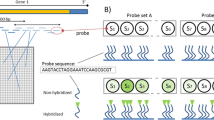Abstract
As the quality of microarrays is critical to successful experiments for data consistency and validity, a reliable and convenient quality control method is needed. We describe a systematic quality control method for large-scale genome oligonucleotide arrays. This method is comprised of three steps to assess the quality of printed arrays. The first step involves assessment of the autofluorescence property of DNA. This step is convenient, quick to perform, and allowed reuse of every array. The second step involves hybridization of arrays with Cy3-labeled 9-meroligonucleotide target to asess the quality and stability of oligonucleotides. Because this step consumed arrays, one or two arrays from each batch were used to complement the quality control data from autofluorescence. The third step involves hybridization of arrays from every batch with transcripts derived from two cell lines to asess data consistency. These hybridizations were able to distinguish two closely related tissue samples by identifying a cluster of 20 genes that were differently expressed in U87MG and T98G glioblastoma cell lines. In addition, we standardized two parameters that significantly enhanced the quality of arrays. We found that longer pin contact time and crosslinking oligonucleotides at 400 mJ/cm2 were optimal for the highest hybridization intensity. Taken together, these results in indicate that the quality of spotted oligonucleotide arrays should be assessed by at least two methods, autofluorescence and 9-mer hybridization before arrays are used for hybridization experiments.
Similar content being viewed by others
References
Hegde, P., Qi, R., Gaspard, R., et al. (2001) Identification of tumor markers in models of human colorectal cancer using a 19,200-element complementary DNA microarray. Cancer Res., 61, 7792–7797.
Bekal, S., Brousseau, R., Masson, L., Prefontaine, G., Fairbrother, J., and Harel, J. (2003) Rapid identification of Escherichia coli pathotypes by virulence gene detection with DNA microarrays. J. Clin. Microbiol. 41, 2113–2125.
Bhattacharya, B., Miura, T., Brandenberger, R., et al. (2004) Gene expression in human embryonic stem cell lines: unique molecular signature. Blood 103, 2956–2964.
Bloom, G., Yang, I. V., Boulware, D., Kwong, K. Y., Coppola, D., Eschrich, S., Quackenbush, J., Yeatman, T. J. (2004) Multi-platform, multi-site, microarray-based human tumor classification. Am. J. Pathol. 164, 9–16.
McGall, G., Labadie, J., Brock, P., Wallraff, G., Nguyen, T., and Hinsberg, W. (1996) Light-directed systhesis of high-density oligonucleotide arrays using semiconductor photoresists. Proc. Natl. Acad. Sci. USA 93, 13,555–13,560.
Schena, M., Shalon, D., Davis, R. W., and Brown, P. O. (1995) Quantitative monitoring of gene expression patterns with a complementary DNA microarray. Science 270, 467–470.
Duggan, D. J., Bittner, M., Chen, Y., Meltzer, P., and Trent, J. M. (1999) Expression profiling using cDNA microarrays. Nat. Genet. 21, 10–14.
Liu, Y. and Rauch, C. B. (2003) DNA probe attachment on plastic surfaces and microfluidic hybridization array channel devices with sample oscillation. Anal. Biochem. 317, 76–84.
Okamoto, T., Suzuki, T., and Yamamoto, N. (2000) Microarray fabrication with covalent attachement of DNA using bubble jet technology. Nat. Biotechnol. 18, 438–441.
Hughes, T. R., Mao, M., Jones, A. R., et al. (2001) Expression profiling using microarrays fabricated by an ink-jet oligonucleotide synthesizer. Nat. Biotechnol. 19, 342–347.
Reese, M. O., van Dam, R. M., Scherer, A., and Quake, S. R. (2003) Microfabricated fountain pens for high-density DNA arrays. Genome Res. 13, 2348–2352.
Battaglia, C., Salani, G., Consolandi, C., Bernardi, L. R., and De Bellis, G. (2000) Analysis of DNA microarrays by non-destructive fluorescent staining using SYBR Green II. Biotechniques 29, 78–81.
Shearstone, J. R., Allaire, N. E., Getman, M. E., and Perrin, S. (2002) Nondestructive quality control for microarray production. Biotechniques 32, 1051–1057.
Experimental protocol (http://cmgm.stanford.edu/pbrown/protocols/index.html)
NCI microarray manual (http://nciarray.nci.nih.gov/reference/nciarrayspacket01-04A.pdf)
Microarray database (mAdb) (http://nciarray.nci.nih.gov)
Wang, H. Y., Malek, R. L., Kwitek, A. E., et al. (2003) Assessing, unmodified 70-mer oligonucleotide probe performance on glass-slide microarrays. Genome Biol. 4, R5.
Hessner, M. J., Meyer, L., Tackes, J., Muheisen, S., Wang, X. (2004) Immobilized probe and glass surface chemistry as variables in microarray fabrication. BMC Genomics 1, 53–60.
Hessner, M. J., Wang, X., Hulse, K., et al. (2003) Three color cDNA microarrays: quantitative assessment through the use of fluorescein-labeled probes. Nucl. Acids Res. 31, e14.
Joshi, B. H., Plautz, G. E., and Puri, R. K. (2000) Interleukin-13 receptor alpha chain: a novel tumor-associated transmembrane protein in primary explants of human malignant gliomas. Cancer Res. 60, 1168–1172.
User Manual (http://www.Genomicsolution.com/files/genomics)
Wang, X., Ghosh, S., and Guo, S. W. (2001) Quantitative quality control in microarray image processing and data acquisition. Nucleic Acids Res. 29, E75–5.
Hautaniemi, S., Edgren, H., Vesanen, P., et al. (2003) A novel strategy for microarray quality control using Bayesian networks. Bioinformatics 19, 2031–2038.
Gollub, J., Ball, C. A., Binkley, G., et al. (2003) The Stanford Microarray Database: data access and quality assessment tools. Nucleic Acids Res. 31, 94–96.
Burgoon, L. D., Eckel-Passow, J. E., Gennings, C., et al. (2005) Protocols for the assurance of microarray data quality and process control. Nucleic Acids Res. 33, e172.
Kim, K., Page, G. P., Beasley, T. M., Barnes, S., Scheirer, K. E., and Allison, D. B. (2006) A proposed metric for assessing the measurement quality of individual microarrays. BMC Bioinformatics 7, 35.
Author information
Authors and Affiliations
Corresponding author
Rights and permissions
About this article
Cite this article
Yang, A.X., Mejido, J., Bhattacharya, B. et al. Analysis of the quality of contact pin fabricated oligonucleotide microarrays. Mol Biotechnol 34, 303–315 (2006). https://doi.org/10.1385/MB:34:3:303
Issue Date:
DOI: https://doi.org/10.1385/MB:34:3:303




